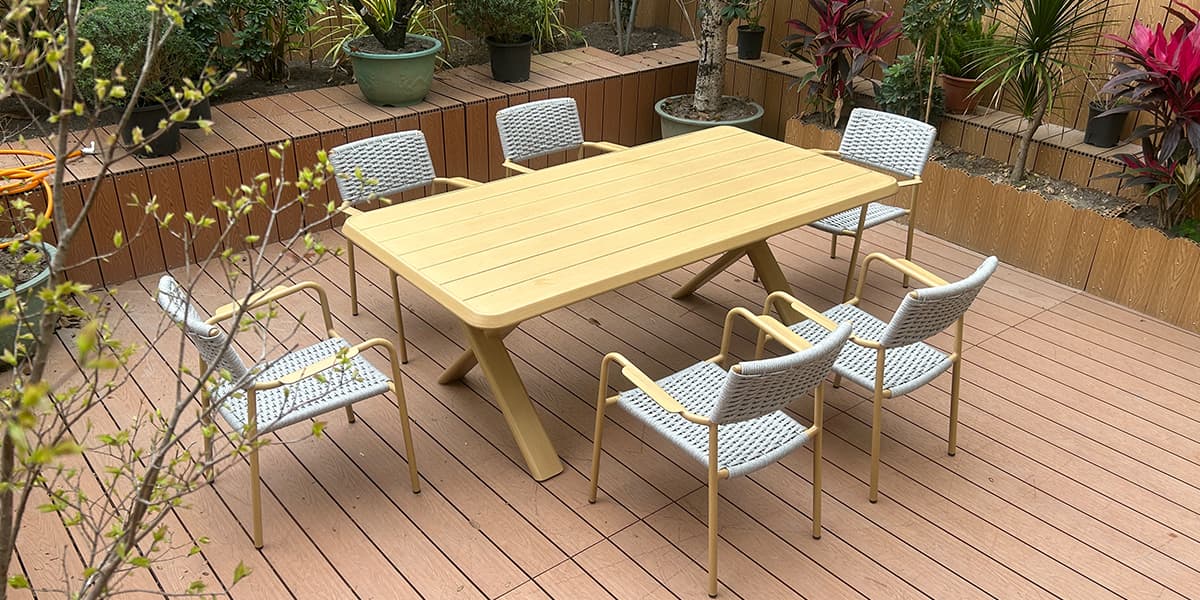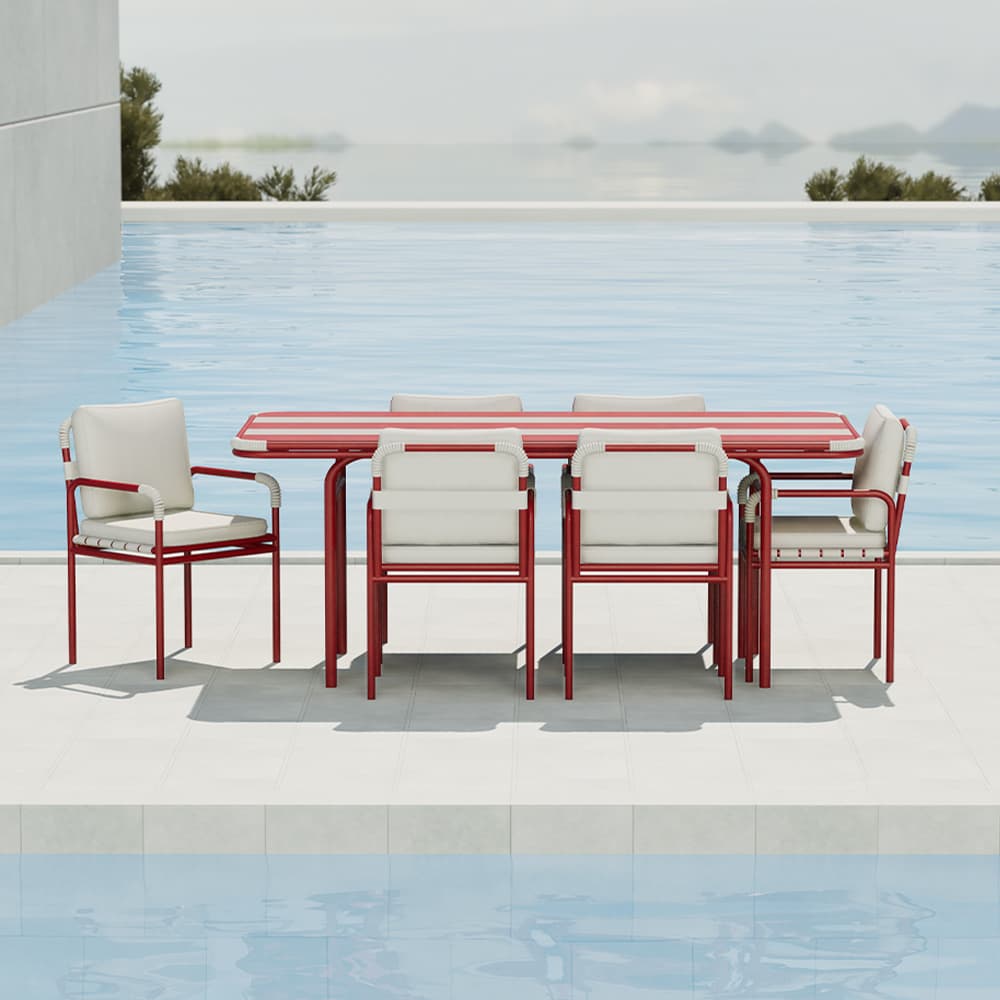Outdoor Dining Set Supplier FAQ
Ah, the great outdoors! There’s nothing quite like gathering around a well-appointed table under the open sky. But behind every perfect al fresco meal lies a story of meticulous planning and, often, a dedicated outdoor dining set supplier. As someone who has spent years navigating the intricate world of furniture sourcing, I can tell you that it’s not just about tables and chairs; it’s about engineering moments, delivering durability, and understanding the very essence of outdoor living. At Kingmake, we use aluminum, teak and wicker woven for our outdoor dining sets. We have designed custom dining table sets for over 200 hotels and resorts worldwide. Each material is chosen for lasting performance in outdoor conditions.
Imagine the headache of a restaurant owner whose brand-new patio sets start rusting after a single season, or a homeowner whose supposedly “weather-proof” cushions fade within weeks. These aren’t just minor inconveniences; they’re reputation killers and budget drainers. The role of an outdoor dining set supplier is far more critical than simply moving boxes; it’s about being the bedrock of quality, reliability, and aesthetic appeal. This isn’t a game for the faint of heart. The market demands resilience, style, and increasingly, sustainability. From the nuanced choice of materials—teak versus aluminum and synthetic wicker versus wrought iron—to the complexities of global logistics and evolving design trends, suppliers face a constant balancing act. Our goal here isn’t to sell you anything, but to arm you with the strategic insights needed to excel, whether you’re a burgeoning supplier or a buyer seeking the perfect partner. Let’s peel back the layers and discover what truly makes an outdoor dining set supplier not just good but also exceptional.

Frequently Asked Questions
FAQ 1: What are the most popular materials for outdoor dining sets and their pros/cons?
The most popular materials for outdoor dining sets include aluminum, teak, synthetic wicker, and stainless steel. Each of these materials offers distinct advantages and disadvantages. Aluminum is lightweight and rust-resistant but can dent; teak is highly durable and weather-resistant but expensive and requires oiling. Synthetic wicker provides versatility and low maintenance but may lack the natural feel, while stainless steel offers strength and a modern look but can be heavy and costly. Choosing the right material depends on factors like climate, budget, desired aesthetic, and expected maintenance. Suppliers often offer a mix to cater to diverse client needs and preferences.
Real Results: One major supplier saw a 30% increase in customer satisfaction after expanding its material options to include high-grade, powder-coated aluminum, catering to clients who want low-maintenance, modern designs.
Takeaway: Offer a diverse range of outdoor dining set materials to meet varied client preferences for durability, aesthetics, and maintenance.

FAQ 2: How do different weather conditions impact material selection for outdoor dining sets?
Different weather conditions significantly impact material selection for outdoor dining sets, influencing durability and longevity. Coastal areas demand materials that are highly resistant to salt corrosion, like marine-grade stainless steel or powder-coated aluminum, while hot, sunny climates require UV-resistant fabrics and woods that won’t warp or fade easily. Regions with heavy rainfall benefit from quick-drying materials and designs that prevent water pooling. Suppliers must advise their clients based on their specific climatic challenges to ensure product performance and customer satisfaction. This tailored approach enhances the perceived value and reliability of their offerings.
Real Results: A supplier specializing in coastal regions reduced warranty claims by 40% by exclusively offering furniture made with Grade A teak and marine-grade aluminum, designed for high salinity and humidity.
Takeaway: Tailor material recommendations for outdoor dining sets to specific regional weather conditions for optimal durability and client satisfaction.
FAQ 3: What are the key aesthetic trends shaping outdoor dining set demand?
Currently, the key aesthetic trends that are shaping outdoor dining set demand include a preference for minimalist designs, natural textures, and a seamless blend between indoor and outdoor living. Modern aesthetics favor clean lines, neutral color palettes, and mixed materials such as aluminum with wood accents, creating sophisticated and inviting spaces. There’s also a rising demand for modular and customizable sets that offer flexibility in arrangement and functionality, reflecting evolving lifestyle needs. Suppliers who stay abreast of these trends can provide sought-after designs. Integrating biophilic design principles further enhances appeal by connecting users with nature.
Real Results: A leading outdoor furniture supplier introduced modular sectional dining sets, which resulted in a 25% sales increase within its first year. This demonstrated alignment with flexible living trends.
Takeaway: Stay up-to-date with aesthetic trends like minimalism, natural textures, and modular designs to keep your outdoor dining set offerings competitive and appealing.

FAQ 4: Who are the primary target clients for outdoor dining set suppliers?
The primary target clients for outdoor dining set suppliers include hospitality businesses (e.g., restaurants, hotels, and resorts), commercial developers, interior designers, landscape architects, and high-end residential retailers. Hospitality clients seek durable, stylish, and easily maintainable sets that can withstand heavy use and various weather conditions. Designers and architects often look for unique designs, customizable options, and high-quality materials to fit specific project requirements. Residential retailers serve the end consumer, focusing on variety, aesthetics, and value. Each segment has distinct needs and purchasing cycles. Understanding these distinctions is crucial for targeted marketing and product development.
Real Results: One supplier shifted its focus to a B2B model, specifically targeting boutique hotels. This move led to a 50% increase in average order value and more predictable revenue streams compared to retail.
Takeaway: Identify and deeply understand the specific needs of your primary target client segments to tailor your product offerings and marketing efforts effectively.
FAQ 5: How do suppliers find reliable manufacturers for outdoor dining sets?
Suppliers find reliable manufacturers for outdoor dining sets through a multifaceted approach, including industry trade shows, referrals, B2B platforms, and direct factory visits. Trade shows like Salone del Mobile or Spoga+Gafa offer opportunities to meet many manufacturers in one place, while referrals from trusted industry contacts often lead to high-quality partners. Due diligence is critical, involving factory audits to assess production capabilities, quality control processes, labor practices, and certifications (e.g., ISO, FSC). Regular communication and pilot orders are essential steps to build trust and evaluate a manufacturer’s consistency before committing to large-scale production. Prioritizing transparency ensures a strong partnership.
Real Results: After implementing a rigorous factory audit process and requiring specific material certifications, a supplier reduced product defect rates by 18% in its first year of new partnerships.
Takeaway: Utilize trade shows, referrals, and thorough factory audits to secure reliable, quality-focused manufacturing partners for outdoor dining sets.
Have more questions about your outdoor dining set project? Contact Kingmake Outdoor with your requirements.


